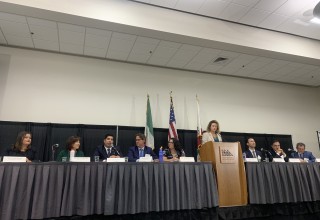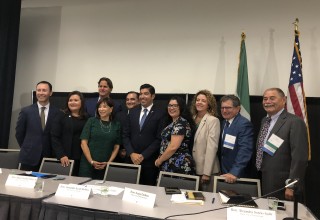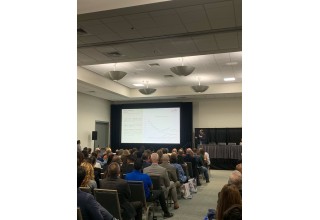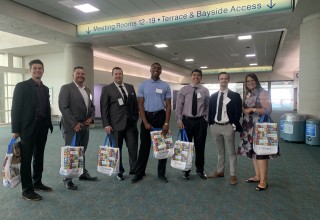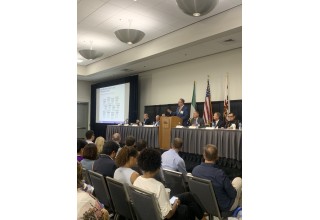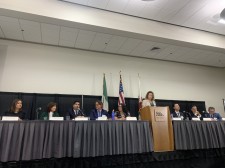
Elected officials, economists and business leaders gathered to discuss growth and future opportunities of the South Bay and Baja region at the South County Economic Development Council's 29th Annual Economic Summit
SAN DIEGO, September 17, 2019 (Newswire.com) - Panelists and speakers at the South County Economic Development Council’s 29th Annual Economic Summit came together today to discuss the opportunities the South Bay holds to provide affordable housing, sustainable employment options, and future education systems while addressing current economic challenges that may be ahead. The Summit’s Masters of Ceremony included Bob Penner, HomeFed Corporation; Hon. Dukie Valderrama, Commissioner of the Port of San Diego; and Tony McCune, founding member of SCEDC.
Nearly 600 of San Diego’s business leaders and public officials gathered for the South County Economic Development Council’s 29th Annual Economic Summit. The summit offered attendees a comprehensive look into the San Diego South Bay and Baja region’s latest business development and economic outlook news.
“This year we are celebrating 30 years of focused economic growth and expansion in the South Bay region through the efforts of the South County EDC. This success can be seen in how much the Economic Summit has flourished in its 29 years. Our keynote speakers and panelists are proof of this, but, most importantly, it can be witnessed in the continued upward development happening in South County,” said Cindy Gompper-Graves, CEO of the SCEDC.
Kelly Cunningham, Senior Economist of San Diego Institute for Economic Research; Ray Major, Chief economist at SANDAG; Gary H. London, Senior Principal at London Moeder Advisors; and President of Manpower, Phil Blair rounded out the economic panel.
Ray Major, Chief Economist at SANDAG, shared insights into the regional plan and how it will positively affect the South Bay region. Only 30% of people in South Bay live and work in the area - which means 70% of people who live in South County are going north to work. Approximately 13,500 people travel between South County and Kearny Mesa, and 11,700 to Downtown. “As part of the regional transportation plan we are currently working on, we are taking a look at the nexus between jobs and housing, and we are trying to find out what’s the best way to move one person from one place to another,” said Ray Major.
During the panel, Cunningham discussed the outlook of a recession in the near future of the United States. Cunningham pointed to the clear presence of an inversion in our current economic climate as being the indicator of a looming recession. An inversion is when the interest rates on short-term bonds are higher than the interest rates paid by long-term bonds.
"We know a recession is coming sometime, we just don't know when ... maybe next year, maybe 2021. For now, by almost any measure, the economy seems fine. GDP is robust enough, unemployment near a 50-year low, stock market up 50% since 2016. Yet, we are coming to an end of unprecedented business cycle growth,” said Cunningham.
The economic panel continued onto the subject of housing demand and affordability and what those effects look like in the South Bay region. The disconnect between where people live and where people work was stressed and providing viable alternative transportation options was presented as a clear solution. Gary London spoke about the significant supply and demand imbalance of housing, particularly in the South Bay. The current demand for new housing units each year is 15,000 to 20,000 new units.
“If we are to cure the problems in the housing market, we need to reach beyond fees, regulations and set aside for affordable housing aimed at developers. We need to invite the entire business community to help to house their own,” said London.
“While we are concerned about attracting and keeping great high tech talent in San Diego, we also feel equally concerned about being inclusionary and upgrading the skills of lesser trained San Diegans. They deserve to prosper as well,” said Phil Blair of Manpower.
The Summit continued with a presentation about the USS Midway from Captain Doug Bradt, a retired U.S Naval Aviator who has worked as a docent onboard the USS Midway Museum for the past six years. Bradt discussed the many voyages, missions, and remodels the USS Midway has gone through. He stated that, annually, the aircraft carrier turned museum receives 1.4 million visitors. Bradt was followed by Hon. Jesus Mario Chacón Carillo, a Mexican Ambassador. Carillo presented on the relationship between the United States and Mexico. Carillo highlighted the 5.8 million U.S. jobs that are supported by direct trade with Mexico, which translates to one of every 29 jobs relies on preserving a relationship with Mexico. Some of these companies include Interjet, Cinepolis, and Bimbo.
The second panel included elected officials from South County and the Baja region. Among those present were Luis Moreno, State Congressman of Baja California; Alejandra del Carmen Leon Gastelum, Senator of Baja California; Mayor Mary Casillas-Salas of Chula Vista; Mayor Alejandra Sotelo-Solis of National City; Pat Aguilar, Mayor Serge Dedina of Imperial Beach; Councilmember Vivian Moreno of the city of San Diego; and Rafael Castellanos, Chairman for the Port of San Diego.
With a diverse panel from both sides of the border, many important topics were covered including border relations, the upcoming Chula Vista Bayfront Project, Tijuana River sewage, and education in the region. Mayor Mary Salas discussed the subject of political relations across the border and its effect on the South Bay and Baja region.
“We have been through cycles where we have had politicians on high levels try to demonize relationships between our two countries. What’s happened is that neighbor to neighbor, business to business, our relationships continue to grow strongly. Whatever is happening at the top politically, we cannot lose focus that trade and commerce are really important to the health of Canada, the United States, and Mexico,” said Mayor Salas.
The elected official panel continued to emphasize the opportunity that South Bay holds for creating more jobs and boosting the economy of San Diego. Chairman Rafael Castellanos of the Port of San Diego talked about the latest updates to the San Diego Bayfront project that is a 1,600-room resort and convention center to be operated by Gaylord Hotels and has now become the biggest private/public project in the history of San Diego County and has been coined the “future of the Port of San Diego.”
“We expect to break ground hopefully in summer of 2020,” said Chairman Castellanos. “The first phase of this project is the resort and convention center and that is a $1.1 billion dollar project. This project is a game-changer. There hasn’t been a world-class facility like this in the South Bay, and now it is coming. It’s something we can all be very proud of in the South Bay,” said Chairman Castellanos.
The elected official discussion rounded out with the topic of education and improvements being made to the system in the South Bay region. Mayor Salas discussed the idea of creating a Bi-National University in the South Bay that would serve both sides of the border. This would be the first four-year university south of the 8 Freeway and the only of its kind in the South Bay. Mayor Sotelo-Solis of National City went on to speak about the opportunities being created by the Mid-Coast Trolley Project.
“As a first-generation college student, I remember going up to UCSD, and it took two hours by transit for me to get to class. Now, the Mid-Coast Trolley and transportation hubs will be connecting students to that campus in 30 minutes. It says to these students that we want you there, and we are going to get you there,” said Mayor Sotelo-Solis.
The Summit ended with Keynote Speakers, California State Treasurer Fiona Ma and Dr. Connie Mariano from the Center for Executive Medicine.
State Treasurer Fiona Ma is the first woman of color and the first Certified Public Accountant in this role. California is the fifth-largest economy in the world; the State Treasurer goes through 2 trillion in payments in a typical year and oversees an investment portfolio of over 90 billion dollars.
Fiona Ma touched upon several important topics involving California’s economic outlook. Opportunity zones were among the topics discussed, mentioning there are 879 zones that were created that would give a tax deferral to investors if they invested in these zones. Those who have opportunity zones and want to move investment into these zones were encouraged to talk to elected officials, assembly members, and senators about some of the projects they have and what this extra investment could do to build or provide financing.
She also addressed the housing industry in California and the obstacles to be tackled. “If we are going to continue to grow our economy, to bring jobs in, to keep companies growing here in California, we are going to have to tackle this housing crisis,” said State Treasurer Fiona Ma. “We look to all of the cities and counties for all of your help and as the financing arm for California I am doing my part to streamline our processes and to make sure that the State is not going to hamper the creating of housing.”
Dr. Connie Mariano closed the summit with a moving speech about the life lessons throughout her successful career. Dr. Connie is the first military woman director of the White House medical unit and served nine years at the White House, where she was physician to three sitting American Presidents. Dr. Mariano is from South San Diego County and graduated as Valedictorian from Mar Vista High School in Imperial Beach, California in 1973.
Dr. Mariano shared how her obstacles and lessons led her to her success, and what she took from her nine years at the White House, including learning from predecessors, knowing that you serve something bigger, taking care of the people that serve under you, knowing what the true purpose of your job is, and more.
“San Diego and South Bay are my roots - I owe everything I am today to San Diego, to South Bay,” said Dr. Connie Mariano. “Don’t let someone tell you that you won’t account to much because you are from South Bay - don’t accept that, that’s not true, we’ve already broken that.”
Each year at the Summit, the SCEDC awards local community and business leaders in the South County and Baja regions for personal and professional efforts that make a direct impact on the economic development in the communities in which they live and work.
· Tony McCune Regional Leadership Award to Kelley Bacon, Deputy City Manager of the City of Chula Vista, sponsored by Tony McCune. Kelley has more than 30 years of public sector experience. Kelley’s leadership has been monumental in crafting policies, regulations and processes for the cannabis industry in Chula Vista. Kelley’s effective strategies, her focus on public safety and extensive community engagement have positioned her as a leader among both local government peers and cannabis industry professionals.
· The Bi-National Endeavor Award was sponsored by SDG&E and was presented to Patricia Alvarez de los Cobos. Patricia is the President and Founder of Energy Communication Corporation (ECC), an advertising firm establishment 30 years ago, that unites the Hispanic and American cultures. Her service to the bi-national community includes serving on multiple boards, broadcasting information to the Hispanic community and creating awareness of local news and issues to a bi-national audience.
· The Corky McMillin Best of South County Award to Small Business Development Center (SDBC) in National City. In 2018, SDBC provided assistance to 3,019 small businesses, producing 162 new businesses, 785 jobs, $62.5 million in sales increases and 83 million in Loans/Equity financing. It is because of their team’s passion for helping small businesses, SDBC’s stellar reputation and collaboration with economic development partners has thrived.
· The Outstanding Corporate Citizen Award sponsored by U.S. Bank was presented to Seven Mile Casino. Seven Mile Casino has made a significant impact as not only a supporter but as a true partner of the South Bay community. Seven Mile Casino has active partnerships with multiple organizations in South Bay. In addition, Seven Mile Casino financially supports the community with as much as $220,000 donated to local non-profits over the past year.
· The Pioneer Award, sponsored by the City of Imperial Beach, was presented jointly to Pack and Bianes Vision Care and the Chula Vista Charitable Foundation (CVCF). Both organizations were vital in the success of South County EDC’s “I Can See My Future” program, which trained 41 students in the optical field. Pack and Bianes were instrumental in the program by identifying a class instructor, contributing to the curriculum and helping in the selection process of students and with the orientation process. The CCVF funded the program through a $35,000 grant, as well as served as a consistent member of the program committee.
· The Marilynn Lassman Golden Dedication Lifetime Achievement Award was awarded to Bill Tunstall, a board member of the SCEDC, sponsored by the City of Coronado. Referred to by South County EDC staff as their “angel,” Bill has dedicated a large portion of his time to serving and supporting South County EDC committees and was crucial in South county EDC’s seamless transition in relocating offices. His input extends throughout a vast number of SCEDC projects, initiatives and publications.
The Summit is the largest public forum the South County EDC holds annually. For more information on the Summit and upcoming South County events and development, visit www.southcountyedc.com or email scedc@southcountyedc.com.
Source: South County EDC
Share:

